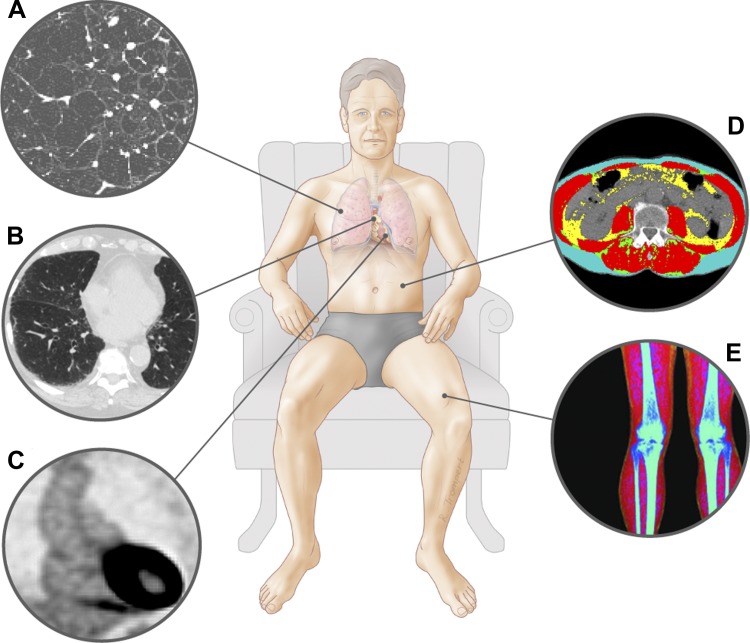Work package 7
Imaging of the lungs, extra-pulmonary tissue and body composition in the PRIL cohort
Detection of early stage disease in the PRIL cohort (WP4) is not only possible with wearable devices (WP5) and multiomics approaches (WP6), but also by imaging modalities.
Lung diseases have traditionally been diagnosed and assessed simply by spirometry. This reliance on spirometry has led to modest advances in our understanding of underlying pathophysiology of many lung diseases. It is increasingly recognized that the development of many lung diseases is complex. Many lung diseases are heterogeneous. Recent advances in CT of the chest have enabled extensive phenotyping by allowing morphologic characterization of parenchymal and airways disease, but also extra-pulmonary components.
Muscle, bone and fat are implicated as the major determinants of the metabolic milieu. It is however difficult to get a reliable qualitative and quantitative overview of these determinants with current tests. The advance of radiological imaging is that it captures not only the lungs (parenchymal disease and airways disease), but also provides important information on body composition and vasculature. CT thus enables visualization of structural derangements.
Computed tomography (CT-) scans of the chest might be able to detect deviations before patients notice any symptoms, but currently they are only used when patients present with complaints at their doctor. Also, approaches for the analysis of CT scans are mostly visual and semi-automatic, while there is a need for automatic unbiased methods making use of the rich information source CT imaging is.
The aim of this work package is to detect lung damage at an early stage using CT, and to develop an automatic method to measure pulmonary and extra-pulmonary (body composition and vasculature status) features on chest CT. Also artificial intelligence by deep learning will be performed on the CT scans to provide an unbiased analysis.
Low dose non-contrast computed tomography scan of the thorax during inspiration and expiration will be done at visit 1 of participants of the PRIL-cohort (baseline) that receive the deep phenotyping (250 high risk, all 100 moderate risk to respiratory disease subjects). At visit 6 (5 years after the first visit) the low dose CT will be repeated. No CT scans will be performed during visits 2, 3, 4 and 5 because it is hypothesized that changes will mainly occur during a longer period of time.
Advanced automatic quantitative imaging analyses of computed tomography (CT) scans of the thorax will be performed to detect factors associated with early changes in lung damage. Not only pulmonary features (including parenchymal and (small) airways), but also extra-pulmonary tissue, including vascular structures and information on body composition (muscle, bone mineral density and muscle and fat quantification and distribution) will be analyzed.
The deliverable of this work package is automatic methods for a whole CT analysis of both pulmonary and extra-pulmonary features. The second deliverable is information on the association of pulmonary and extra-pulmonary features on chest CT with presence of lung damage and/or development of lung damage. Results will be linked to biomarkers acquired in the PRIL cohort (WP5/6) and combined in WP8.

Figure 8 Imaging techniques. A: thoracic CT image of patient with emphysema. B: thoracic computed tomography (CT) image of patient with interstitial lung abnormalities. C: positron emission tomography image displaying fluordeoxyglucose uptake in the aortic wall (image courtesy of Dr. Jan Bucerius). D: abdominal CT with different body composition compartments at the 3rd lumbar vertebra. E: dual-energy X-ray absorptiometry scan leg with different body composition compartments. Figure from Sanders et al19.
